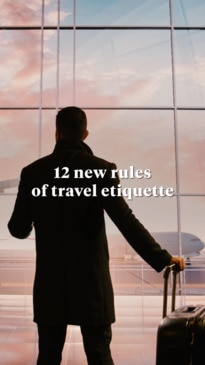7 things Australian travellers need to know about visas right now
Need help working out which countries need a visa? How, where and when to apply? And why the process is so confusing? You're not alone. Escape's travel expert Doc Holiday is here to help.

Lifestyle
Don't miss out on the headlines from Lifestyle. Followed categories will be added to My News.
These are strange times for Australians. Long gone are the days of visa-free travel, replaced by a sea of complicated visa-waiver programs, “will they or won’t they?” announcements, and chaos at the US border.
Got questions about holiday red tape? We’ve got the answers.
We’re heading to Europe later this year. Will we have to apply for the ETIAS visa waiver?
Great news. There is nothing (besides cold, hard cash) between you and those canal-side gelatos in Venice because the European Union has once again revised the introduction of the ETIAS (EU Travel Information & Authorisation System). Although previously planned for rollout later this year (not to mention 2024, 2023 and 2022), travellers visiting Europe now no longer need to worry about obtaining an approved ETIAS online for some time. The launch is now set for the tail end of 2026, with the ETIAS not mandatory until at least April 2027.
If you’re new to the ETIAS game, it’s essentially a visa-waiver (similar to the US ESTA) which will grant Australians with full citizenship authorisation to enter the European Schengen zone for periods of up to three months. An online application must be filled out online at etias.com where security questions are asked and a fee of €7 (around $12.45) is paid. Once the authorisation is granted, the ETIAS will be valid for three years, allowing you to visit as many times as you wish.
The list of ETIAS countries which will require travellers to have this travel authorisation changes regularly, but currently you can expect to apply if you’re planning to visit Austria, Belgium, Bulgaria, Croatia, Czech Republic, Denmark, Estonia, Finland, France, Germany, Greece, Hungary, Iceland, Italy, Latvia, Liechtenstein, Lithuania, Luxembourg, Malta, the Netherlands, Norway, Poland, Portugal, Romania, Slovakia, Slovenia, Spain, Sweden and Switzerland once the system rolls out.

Do we need a visa for the UK?
Not quite, but Australians travelling to the United Kingdom will now need to apply for the UK ETA (Electronic Travel Authorisation), their visa waiver system that went live back in January. Although approvals can be lightning quick (I had mine within minutes), they say there’s a 72-hour period for the approval to come back, so it’s best to apply well before departure. You can do this by visiting the gov.uk site and paying the £10 (around $20.85) fee. The good news? Once you have the ETA, it will last for two years or until your passport expires (whichever is sooner). During this time, you can visit the UK as many times as you’d like.
We’d like to visit the United States but we’re worried about being turned away, or worse, being detained. Any updates?
My phone has been running hot these past few weeks with panicked calls from friends, family and acquaintances clutching a ticket to the “Land of the Free”. I can’t say I blame them; instances of travellers having their phones and laptops searched extensively by US Customs and Border Protection, not to mention the number of travellers – even those armed with the appropriate visas and ESTAs (Electronic System for Travel Authorisation) – being detained, before being deported, are growing. Any kind of political activism, from a presence at protests to a single Free Palestine hashtag on a social media post is enough to do it.
The Department of Foreign Affairs and Trade has updated its travel advisory to reflect the added risk at the border, explaining: “US authorities have broad powers to decide if you’re eligible to enter, and may determine that you are inadmissible for any reason under US law”. An approved ESTA or valid visa doesn’t guarantee entry to the United States either, with DFAT adding: “If CBP denies your entry, you may be held at the port of entry or a nearby detention facility while US authorities arrange your return to Australia (or the last country you visited)”.
So will you be detained? Probably not. Try to minimise the risk by deleting any emails, text messages and social media posts which could be deemed problematic on your phone and leaving your laptop at home.
Having all accommodation pre-booked and printing out a detailed itinerary as well as bank statements so your movements and means can be easily viewed is also important. And remember to always apply for either the correct visa or the ESTA.

Please settle a bet between my husband and me: how far in advance do we have to apply for visas?
It’s difficult to provide a one-size-fits-all figure here (some destinations are more efficient than others), but in the interest of marital harmony, I would say apply as soon as you’ve booked your holiday and bought your travel insurance policy, or once visa applications are open for your desired destination.
Applications for a visa to India, for example, can only be made up to 30 days in advance of travel. The basic rule of thumb? Try to have that hot little visa in your hand (or your inbox) at least a month before departure so you’ve got adequate time to check and double-check for any mistakes.
With so many scam sites, what’s the best way to find a country’s visa application site?
Fake travel visa and/or visa waiver websites can now be found for just about every country, making visa-related scams where either your money or your identity are stolen, increasingly common. Happily, confirming the legitimacy of a site is usually as easy as either visiting smartraveller.gov.au or DFAT’s list of Foreign Embassies and Consulates in Australia. Both of these sites usually provide links to the legitimate travel visa or waiver application sites or forms. If you’re unable to find one, your best bet is to contact the relevant embassy or consulate directly to ask for the correct link.
While there are genuine visa processing services around, they’re not only more expensive than the official government channels, they also increase the risk of your information becoming exposed.
If you’re worried you’ve made your application through a dodgy website, contact IDCARE, a national identity and cyber support service, by visiting idcare.org or by calling 1800 595 160.

Why is the Vietnamese visa so problematic? I’m tearing my hair out.
I don’t know if it makes you feel any better about those bald patches, but you’re far from alone: complaints and questions about the dreaded Vietnam visa land in my inbox every week. As it stands, all Australians must apply for an e-visa online through the official site evisa.gov.vn. The cost of a single entry visa is $US25 (about $39) and accuracy is essential, with travellers warned to triple-check all details entered are identical to your passport’s biodata page including full name and date of birth in the correct order.
If the visa contains any errors (and judging by the letters we receive at Escape, many of these errors appear to be made during the application process by officials at the Vietnamese immigration portal rather than the applicants themselves), a last-minute visa will need to be bought at the airport at a cost which can run into the hundreds of dollars. Incorrect information on applications and poor quality photos can also see you pleading for mercy at an airport.
The truth is we really can’t understand why the visa process is so problematic with Vietnam, so do yourself a favour and apply for it as soon as you can (you can apply up to a year in advance of your trip). This will give you time to check (and recheck) everything is in order long before departure.

Who can apply for the United States’ Global Entry program?
Global Entry is a United States Customs and Border Protection program that allows faster customs clearance and immigration for eligible and pre-approved Australians when entering the country. Those accepted into the program enjoy a five-year Global Entry membership, but it’s important to stress – particularly now – that this doesn’t replace any visa requirements for entry into the US.
Australia is processing Global Entry applications in a phased approach and while phase one is now closed, it was limited to Australian citizens with a clean criminal record and no customs or immigration violations who had travelled to the US at least five times in the previous 12 months. Phase two is expected to open later this year, and although further information is to be made available closer to the time, it’s expected all Australian passport holders who meet CBP requirements will be eligible to apply.
How do we know which countries Australians now need visas for?
I know it reads like I’m employed by DFAT, but smartraveller.gov.au is your best source of information, while Skyscanner and Passport Index allow you to quickly see visa requirements by country. Australian passport holders enjoy visa-free entry to 109 countries, but this is changing rapidly. For example, as of last month, Australians require e-visas for Brazil.
More Coverage
Originally published as 7 things Australian travellers need to know about visas right now





